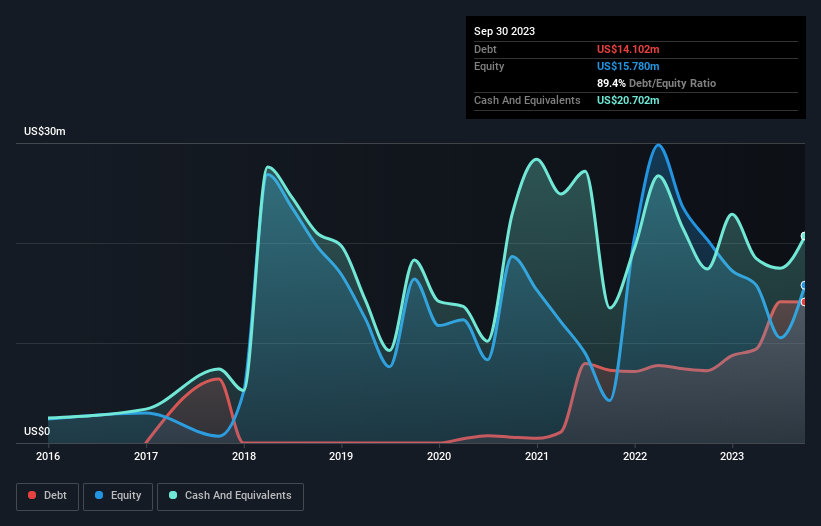David Iben put it well when he said, 'Volatility is not a risk we care about. What we care about is avoiding the permanent loss of capital.' It's only natural to consider a company's balance sheet when you examine how risky it is, since debt is often involved when a business collapses. Importantly, Eyenovia, Inc. (NASDAQ:EYEN) does carry debt. But the real question is whether this debt is making the company risky.
Why Does Debt Bring Risk?
Debt and other liabilities become risky for a business when it cannot easily fulfill those obligations, either with free cash flow or by raising capital at an attractive price. If things get really bad, the lenders can take control of the business. However, a more common (but still painful) scenario is that it has to raise new equity capital at a low price, thus permanently diluting shareholders. By replacing dilution, though, debt can be an extremely good tool for businesses that need capital to invest in growth at high rates of return. The first step when considering a company's debt levels is to consider its cash and debt together.
See our latest analysis for Eyenovia
How Much Debt Does Eyenovia Carry?
As you can see below, at the end of September 2023, Eyenovia had US$14.1m of debt, up from US$7.23m a year ago. Click the image for more detail. But it also has US$20.7m in cash to offset that, meaning it has US$6.60m net cash.

How Strong Is Eyenovia's Balance Sheet?
According to the last reported balance sheet, Eyenovia had liabilities of US$6.55m due within 12 months, and liabilities of US$12.5m due beyond 12 months. Offsetting this, it had US$20.7m in cash and US$897.7k in receivables that were due within 12 months. So it can boast US$2.51m more liquid assets than total liabilities.
This surplus suggests that Eyenovia has a conservative balance sheet, and could probably eliminate its debt without much difficulty. Simply put, the fact that Eyenovia has more cash than debt is arguably a good indication that it can manage its debt safely. The balance sheet is clearly the area to focus on when you are analysing debt. But it is future earnings, more than anything, that will determine Eyenovia's ability to maintain a healthy balance sheet going forward. So if you want to see what the professionals think, you might find this free report on analyst profit forecasts to be interesting.
It seems likely shareholders hope that Eyenovia can significantly advance the business plan before too long, because it doesn't have any significant revenue at the moment.
So How Risky Is Eyenovia?
We have no doubt that loss making companies are, in general, riskier than profitable ones. And in the last year Eyenovia had an earnings before interest and tax (EBIT) loss, truth be told. Indeed, in that time it burnt through US$27m of cash and made a loss of US$25m. Given it only has net cash of US$6.60m, the company may need to raise more capital if it doesn't reach break-even soon. Overall, its balance sheet doesn't seem overly risky, at the moment, but we're always cautious until we see the positive free cash flow. When analysing debt levels, the balance sheet is the obvious place to start. However, not all investment risk resides within the balance sheet - far from it. To that end, you should learn about the 6 warning signs we've spotted with Eyenovia (including 2 which are concerning) .
Of course, if you're the type of investor who prefers buying stocks without the burden of debt, then don't hesitate to discover our exclusive list of net cash growth stocks, today.
Valuation is complex, but we're here to simplify it.
Discover if Hyperion DeFi might be undervalued or overvalued with our detailed analysis, featuring fair value estimates, potential risks, dividends, insider trades, and its financial condition.
Access Free AnalysisHave feedback on this article? Concerned about the content? Get in touch with us directly. Alternatively, email editorial-team (at) simplywallst.com.
This article by Simply Wall St is general in nature. We provide commentary based on historical data and analyst forecasts only using an unbiased methodology and our articles are not intended to be financial advice. It does not constitute a recommendation to buy or sell any stock, and does not take account of your objectives, or your financial situation. We aim to bring you long-term focused analysis driven by fundamental data. Note that our analysis may not factor in the latest price-sensitive company announcements or qualitative material. Simply Wall St has no position in any stocks mentioned.
About NasdaqCM:HYPD
Hyperion DeFi
An ophthalmic technology company, engages in development and commercialization of ophthalmic solutions in the United States.
Medium-low risk with mediocre balance sheet.
Market Insights
Community Narratives




